Samsung Galaxy Nexus & Ice Cream Sandwich Review
by Brian Klug & Anand Lal Shimpi on January 18, 2012 1:34 PM ESTThe UI: Holo Evolved
When I first met Holo, Google's Honeycomb theme, I wasn't convinced that it was something that would last. It was different, which earned Google points for sure, but it wasn't exactly comfortable. I was surprised to see an evolution of Holo used in ICS, but the theme has grown on me.
Ice Cream Sandwich feels a lot like Android meets Windows Phone. Part of that surely has to do with the very contrasty nature of the theme, but it's also the choice of font (Android 4.0 replaces Droid Sans with Roboto) and hard edges sprinkled throughout the UI. Holo is still distinctly Android in that there are still multiple home screens with support for widgets, but it's also different. Ice Cream Sandwich is Android maturing, it's the second implementation of Holo allowing us to finally plot a trajectory for where Google sees this thing going in the near term. It's different as I mentioned before. Holo and ICS aren't iOS nor does it look like they ever will be. The UI is either going to pull you in or turn you off. I like it. It's different, it's clearly a play on the whole Android theme; it's the type of UI you'd expect from an OS named after a robot.

Droid Sans v. Roboto (ICS)
At the same time it's no longer awkward. Elements of the design and many of the first party apps are just clean. It's truly a first class citizen. Different than both iOS and Windows Phone, but with a design that's just as credible.
The core of Android remains unchanged. You get multiple home screens (five by default) that you can populate with shortcuts, widgets or folders. Widgets are resizable just as they were in Honeycomb. Shortcuts work the same way they always have, while Folders get a nice update in ICS. Drag any icon on top of another one and they'll create a folder. Folders are quick to open and easy to rename, just tap on the name of any open folder and type away.
The app launcher gets a bit of a facelift. Instead of an endless scrolling cube, you get pages of apps that you flip through. Once you've reached the end of your pages of apps you'll start flipping through widgets. All of this is smoother than it has ever been on Android.
| Gingerbread vs. Ice Cream Sandwich | ||||
| Gingerbread | Ice Cream Sandwich | |||
| Lock |
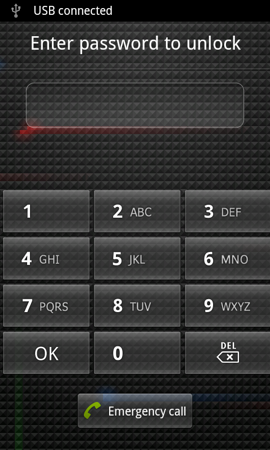 |
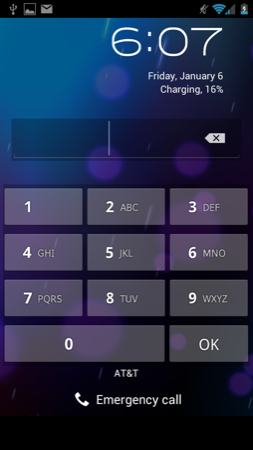 |
||
| Home |
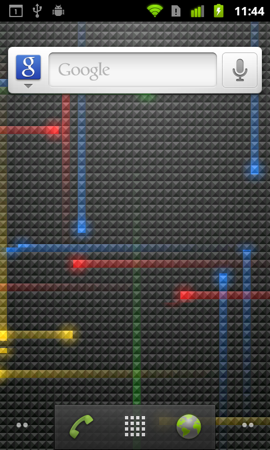 |
 |
||
| Launcher |
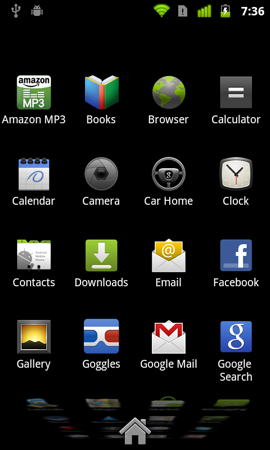 |
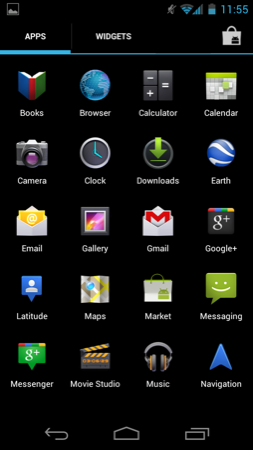 |
||
The New Contextual Menu Button
Play around with ICS for a little bit and you'll quickly pick up on a new UI element that appears inspired by Windows Phone:
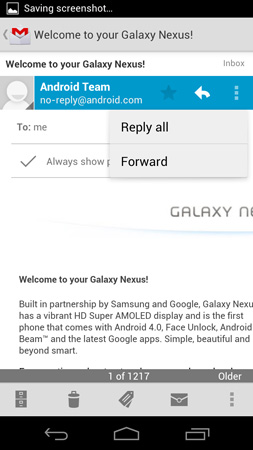
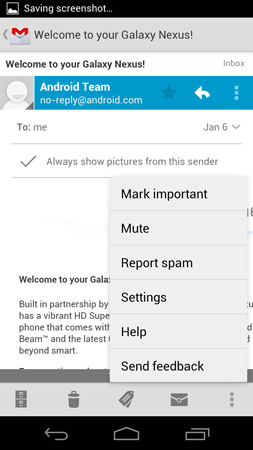
These vertically oriented ellipses will appear at either the top or bottom of an app and reveal additional menu options.
In Gingerbread you had the fixed Android menu button, but with that gone you have to rely on these contextual menu buttons to bring up additional actions. I'm honestly pleased with the move because all too often I'd forget to tap the menu button to see whether or not there were additional options in Gingerbread. ICS makes it very obvious when there's more you can do.
The Task Switcher
A cornerstone of any good operating system is a good task switcher. I still believe that webOS dealt with the concept of individual apps and switching between them better than any other mobile OS, but it looks like that platform is pretty much dead with little chance of making it into the top three mobile OSes.
Google and iOS haven't traditionally focused much on task switching, although both have provided support for it. In Gingerbread, you'd switch between apps by holding down the home button, which brought up a list of up to eight of your most recently used apps. Ice Cream Sandwich implements a drawer-style app switcher menu, first introduced in Honeycomb, activated by hitting the dedicated task switcher button:
| Gingerbread vs. Ice Cream Sandwich | ||||
| Gingerbread | Ice Cream Sandwich | |||
| Task Switcher |
 |
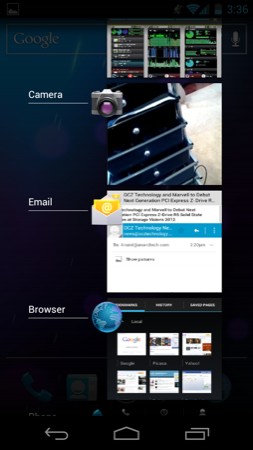 |
||
The Gingerbread method of switching may be quicker, but it's definitely not as useful as what ICS offers. For starters you can switch between more than just six apps in ICS. The most recent apps are located at the bottom of the list, the oldest at the top. You can also quit apps using the switcher by sliding them to the left or right. Doing so immediately frees up any memory the app was using, even if it was suspended.
Scrolling through the list of recent apps, like scrolling pretty much anywhere in ICS, is extremely smooth. The only real complaint I have here is that the task switcher takes far too long to draw initially. As I alluded to before, this is something that may get better with a faster SoC, particularly one with a faster GPU.
The Shade & Notifications
Notifications in ICS are still handled via the status bar at the very top of the screen and a pull down notification shade. The shade in ICS is partially transparent by default and once again, very smoothly animated. The network carrier string is included at the bottom of the shade rather than in the status bar at the top. You can clear notifications individually or hit the X to clear all of them.
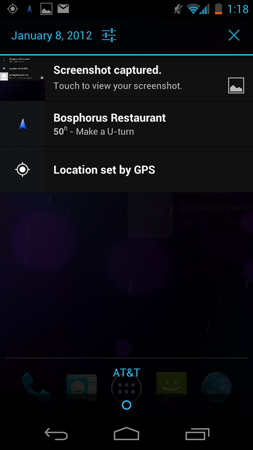
I am surprised Google didn't borrow the quick settings options its partners usually like to stick in the shade, but there is a link to the system settings panel at the top.
Screenshots
Android 4.x also finally enables the ability to take screenshots from within the OS. There's no necessity for OEMs to bake-in their own screenshot functionality and key press combination, no need to connect using USB and fire up ddms, and no need to root and install some application to make it work. Traditionally, those three have been the exclusive way to get screenshots taken on Android.
To take a screenshot in Android 4.x, simply hold volume down and the power/lock button at the same time. An animation plays, you get a notification, and the screenshot is saved (with a timestamped name in PNG format) in /pictures/screenshots as shown above.
I can't emphasize enough how important being able to take screenshots is for a platform in general. Without screenshots, users can only vicariously share a given OS when they're in direct contact with someone else. Being able to take screenshots without all the nonsense I've outlined above is part of what has made iOS so ubiquitous online - browse Reddit and count how many screenshots of SMS conversations (trite as they all are) are clearly from iOS versus Android. It's clear to me that Matias Duarte understands this, since webOS and even the Danger Hiptop since day 1 had the ability to take screenshots. Now Android 4.x finally joins the fray.










185 Comments
View All Comments
Jingato - Friday, January 20, 2012 - link
Why even bother posting a review of a phone that is over a month old? If you want to be a real news /review site you should of had a review the next day. There is no reason not to. period.get your shit together
tipoo - Friday, January 20, 2012 - link
Because they go more in depth than most reviews out there. The ones that post reviews the day after a product launch don't find nearly as many flaws and details as the AT team. There are plenty of other sites for quickie reviews, I like Anandtech for in-depth.Omid.M - Sunday, January 22, 2012 - link
That's unnecessarily harsh. If you're used to the same day "reviews" of Engadget--i.e. NOTHING technical, totally subjective measurements of everything, in the name of being the "first" with a review--then go ahead and keep reading Engadget.Brian and Anand review EVERYTHING in depth: basebands, screens, software, they even have supercurio who is well known dev in Android community for his take on audio processing. Plus, Anand and Brian were covering CES.
Anand, Brian,
Great job as always. I have a chance to pick up a Nexus LTE for $500 (since I don't have an upgrade) but will hold off; might go with iPhone 4S until Krait or iPhone 5 comes out and (hopefully) blows me away.
-Omid
@moids
Harbler - Sunday, January 22, 2012 - link
Why even bother posting a comment if you're not going to read the review? A cursory perusal of the index alone would have answered your question.Anand & Co. take the time required to turn in top-notch, in-depth reviews, and they've been doing it for longer than your favorite gadget review site has even been in business. Anandtech is, in every sense, a *real* review site.
If wholly subjective reviews of devices (provided within hours of launch) are your idea of informative reading, then please return to Engadget or whatever site you strayed from. Unlike Anadtech, sites of the sort you're looking for are a dime a dozen, and you'll find them substantially better suited to your attention span.
vortmax2 - Friday, January 20, 2012 - link
Can Brian or Anand comment on why they believe Samsung used an OMAP 4460 when they only clocked it to 4430 levels? Also, devs at XDA are having a hard time overclocking it to the 1.5GHz/384MHz max values. Any ideas? Thanks! -JamieTripp1717 - Friday, January 20, 2012 - link
Ive had it for over a month now and i upgraded from a galaxy s (epic 4g on Sprint). Watching Blue ray movies i put on my phone are simply amazing. Ive never seen anything better and i work in the electronics dept at sears. Its better than the samsung 7000 led screen. Overall it took a few weeks to really get used to Andriod 4.02 but it is an amazing improvment from 2.3.5. I cant think of too many flaws here. LTE is SOOO much fater than WiMax! i get about 25-30 MB/s when using speedtest. Upload speeds are very fast too, ave. is around 10ish MB/s. Battery life is fantastic compared to my epic 4g. At work i set my ohone to data restrict so i only get calls and texts because in my store there is NO signal at all and after 8 hours from 100% it will drop to 85%. My Epic wouldnt make it through the work day. 720p Super AMOLED+ really makes this phone a winner. Google and samsung working together is a great combo. My ONLY complaint is i wish i had an 8 or higher megapixel camera. But with the added features its pretty darn decent. No complaints except there are a few programs that are still not compatible with 4.0+ (HBOGO). I highly recomend this over any phone out or anything slated to come out for awhile anyways.Amit P - Friday, January 20, 2012 - link
I'm waiting for my THIRD Nexus to come in. I had screen problems with the first two. The screen wasn't as bright as my brothers Nexus with the same settings. The colors weren't as vivid either.Bristecom - Friday, January 20, 2012 - link
Thats why I didnt exchange mine. Even though it has a dead pixel, aside from that, the screen looks great. So I fear getting one with no dead pixels but poor brightness or colors. This screen is the best Ive ever seen. Other super AMOLED plus displays Ive seen have off colors that bother me.Bristecom - Friday, January 20, 2012 - link
I have to say, mine has a dead green subpixel and it is very clear to me even from a distance with green or white screens. Regardless, I didnt bother exchanging it. -Sent from my Galaxy Nexusmedi01 - Saturday, January 21, 2012 - link
A question, I have Galaxy S so can't compare.Could you please comment on whether black is actually black on Nexus as it is on Galaxy's?
I'm asking because dear objective Anand managed to make a photo of it that makes it look gray ("Display" page)